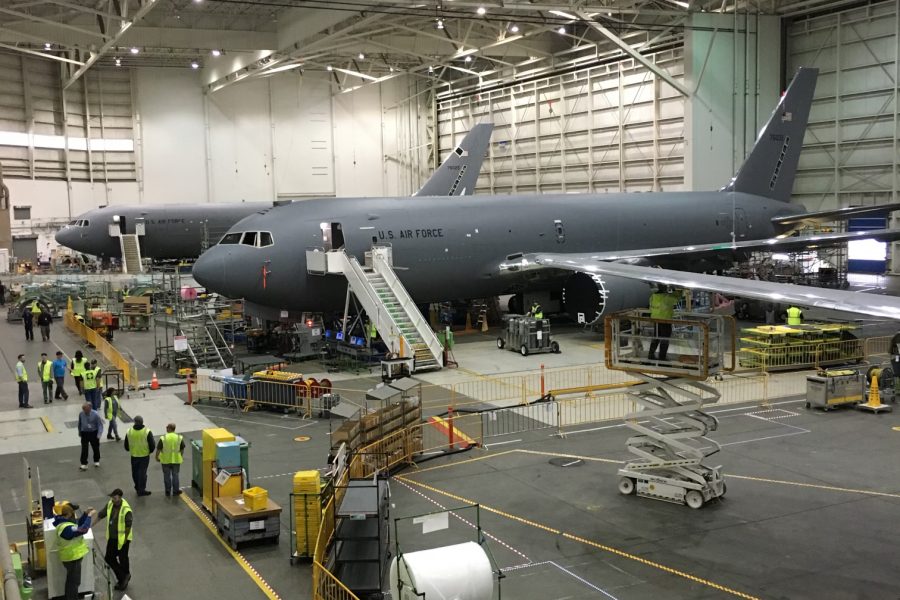The combination of an “unacceptable” eight-year delay, potentially billions of dollars in costs to create a new logistics enterprise, and the need to prioritize a more advanced capability persuaded the Air Force to buy an additional 75 Boeing KC-46s, according to a new document.
The document, posted to Sam.gov on Oct. 2, explains why the Air Force opted in July to skip a competition for a so-called “bridge tanker” and instead press on with more KC-46s until its advanced Next Generation Aerial Refueling System, or NGAS, becomes available in the mid-to-late 2030s.
In the document, Air Force officials wrote they originally wanted a more capable aircraft than the KC-46A to keep tanker production going until NGAS. But they decided it wasn’t worth the expense to obtain an only somewhat enhanced cylinder-and-wing airplane when the priority is NGAS, required to be survivable in future contested airspace.
“The requirements driving an unaffordable, near-term development effort were rescinded and the USAF turned its focus on acceleration of the NGAS program, and requirements development for that effort,” according to the document. When NGAS launched in 2023, the Air Force projected an initial capability around 2040. Now, it’s hoping to get the new tanker sometime around 2036, the document states.
Redactions in the document hide the exact costs the Air Force calculated it would take to run a competition, lay in a new logistics support enterprise, train up new maintainers, and certify vendors. But the service did say a new contest would result in “substantial duplication of cost” in the range of “billions,” without a large increase in capability, while also causing a “substantial delay” in replacing the remaining KC-135s, some of which date back to the 1950s.
The Air Force said it received and reviewed proposals and concepts from some 13 companies for a potential “bridge tanker,” sometimes called KC-Y. But they all had “deficiencies” relative to requirements, even the only production-ready aircraft, the Airbus A330 Multi-Role Tanker Transport. Lockheed Martin and Airbus had originally partnered to offer a version of that aircraft called LMXT, but Lockheed dropped out in October 2023, anticipating that the Air Force couldn’t bear the additional development and logistics cost of a second new tanker, and opted instead to invest in preparing a proposal for the NGAS.
The Air Force said the A330 could only “partially meet” its needs.
This was the second time Airbus has fallen short for an Air Force tanker program. In the early 2000s, the Air Force planned to lease Boeing KC-767s with an intent to eventually buy them, but Congress balked, demanding an open competition for an outright purchase. That was won in 2008 by Northrop Grumman, partnered with Airbus on a variant of the A330. Boeing won a protest of that award, though, and prevailed in the subsequent re-run of the “KC-X” contest, which became the KC-46A program.
The fixed-price Pegasus program has been a huge headache for Boeing, however, which has lost more than $7.5 billion on it. The KC-46 has suffered from a series of technical issues and obsolescence, mainly involving the Remote Vision System used by the boom operator, who sits just behind the cockpit, instead of in the tail, where boomers have traditionally been positioned. The Air Force has put more money into updating the RVS, sharing costs with Boeing.
There have also been issues with overall quality and the refueling boom itself. The Air Force justification acknowledged these and other issues and said Boeing also has to resolve ongoing “diminishing manufacturing … and material shortages” which would affect not only ongoing production but the “bridge” buy, as well.
The new plan calls for buying 75 jets in five lots of 15 over eight years, with the last deliveries being made in 2036. By that time, the Air Force expects to be in production with NGAS. The Air Force said it believes it can get a “fair and reasonable” price from Boeing, even in the absence of competition.
“The final path to NGAS has yet to be defined, given the competing defense priorities,” the Air Force said, but it thinks “an initial capability could be delivered as early as FY2036, with continued acceleration, innovation and funding prioritization.”
Former Air Force Secretary Frank Kendall warned last year that the Air Force would be hard-pressed to fund the development of the Next-Generation Air Dominance fighter, Collaborative Combat Aircraft drones, and NGAS all at once within anticipated budget limits.
The new Trump administration has since awarded the NGAD contract to Boeing and seems prepared to follow through with the CCA program, as well.
Accelerating NGAS is necessary, the Air Force said in the justification, given that the last KC-46 under the previous plan won’t deliver until 2030, and the number bought “will not be sufficient to bridge the gap” between retiring KC-135s and NGAS.
The Air Force issued another request for information to industry in August for NGAS. In September, Lockheed officials said they believe that a stealthy new tanker—not a small one, as has been suggested in recent years—is the Air Force’s urgent need. The company released renderings of potential new, optionally crewed stealth tanker last year.


